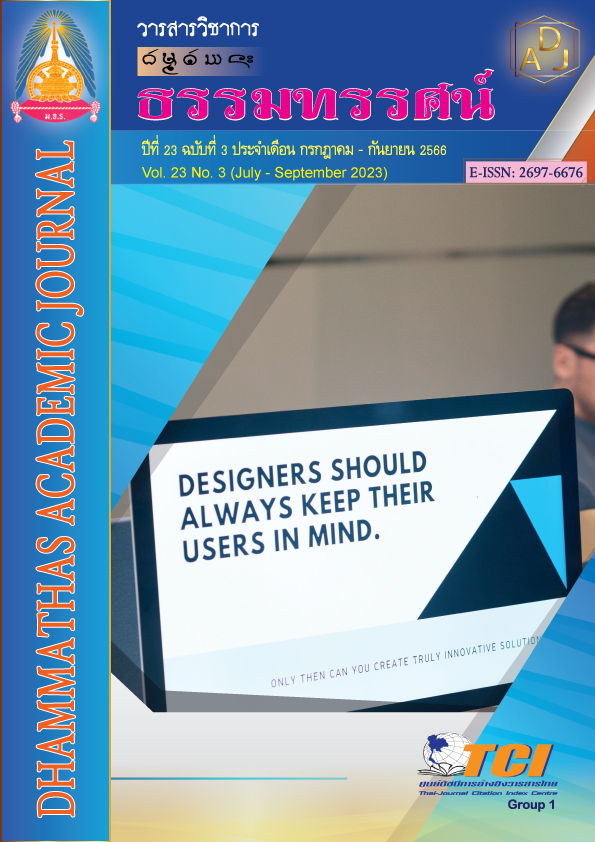The Need Assessment of an Open-Based Creative Learning Environments Model to Promote the Creativity of Undergraduate Student
Main Article Content
Abstract
This research the objectives are 1) analyze and synthesize elements of an open, creative learning environment as a foundation to foster creativity of undergraduate students, 2) study the current conditions and needs of creative open learning environments as a basis for enhancing the creativity of undergraduate students, It is a survey research using a multi-stage random sampling method (Multi-Stage Simple Random). The sample group is 1) Teachers who teach students state university undergraduate students at Supervised universities and private universities in Thailand in the group of faculties and subjects related to Communication Design, totaling 27 people. 2) Undergraduate students in public universities. The study consisted of 55 students in the group of faculties and subjects related to communication arts design. The research was divided into 2 steps: 1) to study the current situation and the need for a creative-based open learning environment to promote the creativity of undergraduate students and 2) to assess the need for a creative-based open learning environment. This was to promote the creativity of undergraduate students using an improved priority need index (PNI modified). The instrument used was a questionnaire on current conditions and needs. The statistics used were frequency, percentage, mean, and standard deviation. Improved Priority need index (PNI modified).
The results showed that:
1. The components of the creative open learning environment as a foundation for promoting creativity of undergraduate students were found to have 6 components: (1) principles and concepts (2) objectives (3) creative process. 4) Creative Open Learning Environment (5) Context (6) Assessment.
2. The overall current condition was at a high level ( = 4.33, S.D. = 0.49) 3). The overall needs and needs were at the highest level (
= 4.75, S.D. = 0.45). The overall needs index was found to be PNI modified = 0.19. When considering each side, it was found that the Mental environment had the highest score (PNI modified = 0.43) and Followed by Information Environment (PNI modified = 0.33) Social Environment (PNI modified = 0.23) Learner Environment (PNI modified = 0.11) Process Environment (PNI modified = 0.10) Physical Environment (PNI modified = 0.09) and teaching environment had the lowest PNI modified (PNI modified = 0.00), respectively.
Article Details

This work is licensed under a Creative Commons Attribution-NonCommercial-NoDerivatives 4.0 International License.
เพื่อให้เป็นไปตามกฎหมายลิขสิทธิ์ ผู้นิพนธ์ทุกท่านต้องลงลายมือชื่อในแบบฟอร์มใบมอบลิขสิทธิ์บทความ ให้แก่วารสารฯ พร้อมกับบทความต้นฉบับที่ได้แก้ไขครั้งสุดท้าย นอกจากนี้ ผู้นิพนธ์ทุกท่านต้องยืนยันว่าบทความ ต้นฉบับที่ส่งมาตีพิมพ์นั้น ได้ส่งมาตีพิมพ์เฉพาะในวารสาร วิชาการธรรม ทรรศน์ เพียงแห่งเดียวเท่านั้น หากมีการใช้ ภาพหรือตารางของผู้นิพนธ์อื่นที่ปรากฏในสิ่งตีพิมพ์อื่นมาแล้ว ผู้นิพนธ์ต้องขออนุญาตเจ้าของลิขสิทธิ์ก่อน พร้อมทั้ง แสดงหนังสือที่ได้รับการยินยอมต่อบรรณาธิการ ก่อนที่บทความจะได้รับการตีพิมพ์References
กระทรวงศึกษาธิการ. (2566). ประกาศกระทรวงศึกษาธิการเรื่องนโยบายและจุดเน้นของกระทรวงศึกษาธิการ ประจำปีงบประมาณ พ.ศ. 2566. เข้าถึงได้จาก https://ops.moe.go.th/360policy-and-focus-moe-2023/
ณัฐกานต์ ภูมิคอนสาร. (2564). ทักษะความคิดสร้างสรรค์ที่หล่นหายไปของผู้เรียนกับการศึกษาในศตวรรษที่ 21. วารสารคณะครุศาสตร์ มหาวิทยาลัยราชภัฏนครสวรรค์, 5(1), 1-9.
ธนาคารแห่งประเทศไทย. (2564). เครื่องชี้ภาวะเศรษฐกิจไทยที่สำคัญ. กรุงเทพฯ: ธนาคารแห่งประเทศไทย.
บุญชม ศรีสะอาด. (2554). หลักการวิจัยเบื้องต้น. (พิมพ์ครั้งที่ 9). กรุงเทพฯ: สุวิริยาสาส์น.
ปาริชาติ บัวเจริญ, นพรัตน์ เตชะพันธ์รัตนกุล และปวันรัตน์ บัวเจริญ. (2562). การศึกษาปัจจัยที่มีส่งผลต่อความคิดสร้างสรรค์ของนักศึกษาระดับปริญญาตรี คณะวิศวกรรมศาสตร์ มหาวิทยาลัยเทคโนโลยีราชมงคลล้านนา เชียงใหม่. วารสารศึกษาศาสตร์ มมร, 7(1), 241-254.
วิชัย วงษ์ใหญ่ และมารุต พัฒผล. (2564). การเรียนรู้เชิงสร้างสรรค์ = Creative Learning. กรุงเทพฯ: บัณฑิตวิทยาลัย มหาวิทยาลัยศรีนครินทรวิโรฒ.
สรวงมณฑ์ สิทธิสมาน. (2563). ความคิดสร้างสรรค์ที่หายไป. เข้าถึงได้จาก https://www.thaipbskids.com/contents/5f6188f917d8e5bbee2401a1
สำนักงานสถิติแห่งชาติ. (2564). สรุปผลที่สำคัญการสำรวจภาวะการทำงานของประชากร พ.ศ. 2564. กรุงเทพฯ: สำนักงานสถิติแห่งชาติ.
สำนักงานสภาพัฒนาการเศรษฐกิจและสังคมแห่งชาติ. (2561). ยุทธศาสตร์ชาติระยะ 20 ปี พ.ศ. 2561-2580. เข้าถึงได้จาก http://nscr.nesdc.go.th
_______. (2564). แผนปฏิรูปประเทศ (ฉบับปรับปรุง) (ฉบับประกาศราชกิจจานุเบกษา). เข้าถึงได้จาก http://nscr.nesdc.go.th,295
สุวิมล ว่องวานิช. (2558). การวิจัยประเมินความต้องการจำเป็น. (พิมพ์ครั้งที่ 3). กรุงเทพฯ: จุฬาลงกรณ์มหาวิทยาลัย.

